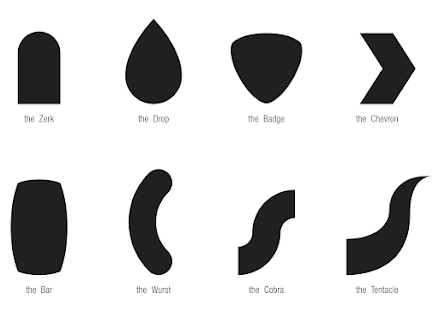LIU CHENG RUI(0370930)
Illustration & Visual Narrative/Bachelor of Design(Honours)in Creative Media
22/4/2024-13/5/2024( WEEK1-WEEK5)
INTRODUCTIONS:
LECTURES:
Week 1:
This week, Mr. Hafiz informed us about illustration and visual storytelling, and gave us some module information.
This module aims to introduce students to the process of creating visual concepts from ideas and communicating images to the audience in the form of illustrations.
He explained what we would learn in this course and showed us our tasks for the semester.
Week 2:
In order to let us know how to use the pen tool, Mr. Wang introduced a game called "Bessel Game" to us.
Fig 1.1 The Bezier Game
After that, the gentleman introduced us to the Vormator Challenge, which will be completed in the next two weeks.
Week 3:
In a character design, iconic(silhouttes), simplicity and uniqueness is important to make the character more memorable.
Iconic:
- Stylized designed characters are often iconic that you can immediately recognize them even in black silhouttes.
Simplicity:
- Simplicity of the design allows viewers to digest and understand the purpose of the characters.
Unique:
- Unique characters makes an impact on the viewers.
Fig 1.2 Principle of character design
Fig 1.3 Principle of character design Shapes are important to identify a character from one another. Explore the possibilities of combining
different interesting shapes for your design. Fig 1.4 Shapes in character design
Colours plays an important role in determining and separate the basic characteristics of heroes, villains and even background characters.
Colours is used to determine and separate the basic characteristics of heroes, villains and even background characters. Different colours give impressions of different emotions and is easily relatable by the viewers.
Exercise 1:
For our exercise this week, we were instructed to use pen tools to trace and recreate vormator shapes in Adobe Illustrator.
Week4:
In painting, the technique refers to the clear tonal contrast suggested by the three-dimensional volume and modeling of objects, as well as figures.
The purpose of contrast is to add drama to a scene through the use of color or light contrast.
Week 5
There are no lectures this week due to the public holiday.
Week 6
There will be no lecture this week because the instructor is not feeling well.
Week 7
Mr. Hafeez explained to us how the next task should be done, and we should make some animated changes based on the album art.
Task 1: Exercise
Exercise 1: The Vortex Challenge
1.1: Use pen Tool to track shapes.
1.2: Vormator Challenge role
Fig1.7 Vormator challenge example

My design is an ancient forest wizard image, the left is his wand, the overall shrunken and small, but the face is very scary
In the fourth week, Mr.Hafiz used the pen tool to draw eight figures in class and told us that we can use these eight figures to design our favorite images. In my opinion, Mr.Hafiz's course seems very interesting, and I can always learn AI knowledge in my own interest.
WEEK4
Lab 2: Chiaroscuro Exercise
We were instructed to use the pen tool, knife tool, shape generator, and Pathfinder tool to design and color the pear shape. We are free to design and divide the shape of the pear.
We were advised to use a knife tool to cut the pear into different shapes and other elements could be added to the design.
Teacher instructed us to trace the shaded area of the skull and place it in the pear.
Later in my studies, I came into contact with many different tools,For example, bend tools and add textures.
Add shadows to illustrations to create texture by using a "grainy effect" combined with linear, radial, and free-form gradients.
Week5
Task 2: Pokemon Card Vormator Challenge and Pokemon Card Creation
This week's class was cancelled because of the public holiday, but it did not affect the fun of the Pokemon assignment. When I first found this assignment, I could not believe it, but it was more of a surprise. So I tried my best to make a scary cow-shaped Pokemon. Fortunately, it didn't look so bad in the end, and I look forward to another assignment like this.
I named it The Magic in the Bottle. It's a high-class Pokemon,In addition to using the pen tool, I also stretched his body part to make it look more in line with his scary image.
Compared with making Pokemon itself, I found it more troublesome to make a suitable background. I searched many pictures of caves online, but without exception, they did not have a relationship between front, middle and back, so I referred to the pictures to complete the background by one geometric figure after another. In order to increase the differentiation, I used the cave entrance as the light source, and the closer I got to Pokemon, the darker it was. Proving to be deep in the cave and using rocks of varying brightness to shape my cave background to look like it matches my Pokemon.
It's a combination of Pokemon and background
Finally, I put together the Pokemon and the background, and describe its skills and characteristics, and my Pokemon is complete.
FEEDBACK
I spent a lot of time creating characters for this Pokemon card task, but fortunately I was satisfied with the final result. For this task, I found that I could use the pen tool more skillfully, which was obviously smoother than the first practice.
REFLECTION
This task was a big challenge for me, which covered almost all the content I had learned before. During this process, I found that I was not fluent in the use of some tools and could not follow the teacher's video operation as smoothly, so I would spend more time to practice.



























Comments
Post a Comment